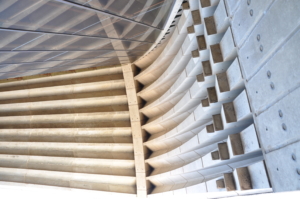When it comes to moving precast concrete steps, the sheer weight of them makes it an issue. Concrete steps are among the heaviest construction items that might be lifted and as well as being difficult, it’s also very time consuming.
Extreme caution is required if you don’t want to injure yourself or others around you. A plan is essential if you want to prevent any costly mistakes when undertaking this concrete repair. It’s not something you can do by hand, even if you’ve got a team of men to help you. What’s required is the right equipment and tools.
Equipment and Tools You Need to Lift The Concrete Stairs
- Gloves to protect your hands
- Truck or light trailer car for transporting the concrete steps
- Forklift for lifting the concrete stairs
- Forklift fork adapter
- Step handling bar for manually lifting the concrete steps
- PVC pipes for moving the concrete steps into place
- Staircase trolley will make the moving process easier
How to Lift and Move Precast Concrete Steps the Right Way?
While moving precast concrete steps can be difficult, it is possible without professional assistance. For the best solution, you’ll need to follow these steps:
Measure the Precast Concrete Steps
The first and most crucial step is a question of math. To save a lot of heavy lifting, you need to keep the concrete steps as near as possible to the house frame and front door, so your first concern is to take the length of the steps into account. If you get this part wrong, you’ll end up with a lot of trouble.
- In general, most concrete steps tend to be 7 inches in height.
- You can expect the width of each step to be between 28 and 36 inches.
Get the tape measure out and check the measurements of your concrete steps, just to be on the safe side. You need to check that the top step is the same level as the floor of your house and the front door for the smoothest transition.
Next, you’ve got to factor in the length of the steps.
This is another critical step in the process because you don’t want a gap between the wall of your house frame and the step. If the gap is too big, you’ve got some heavy lifting to do to match them up.
You also run the risk of bumping the step into the wall and causing significant damage, not just to the wall but the step as well.
With the right amount of planning, accurate measurements, and taking into account your surroundings, you can avoid any serious issues.
Use A Lifting Trailer
Precast concrete steps can weigh as much as a ton, which makes lifting them a massive challenge.
However, before you start worrying about lifting, you need to get yourself a good pair of gloves. You want a pair of gloves that are going to offer the best protection against the rough surface of the concrete steps. A sandpaper finish will also be useful as it helps to improve your grip.
Make sure you know the weight of the steps
Once you’ve got yourself a good pair of gloves, it’s time to start working on moving the concrete steps.
- If your concrete steps are small, they will likely weigh around 700 pounds.
- Bigger concrete steps can weigh anything from 1500 to 2000, which is a lot of weight to be moving around. For such heavy weights, the safest way to move them is with a forklift.
Utilize a forklift adapter
Not only that, but you’ll also need a forklift adapter. This is a forklift attachment that allows you to expand the lifting capabilities of the forklift.
You simply slip the forks into the forklift adapter and secure it to the bulkhead. With this kind of adapter, you can lift barrier walls, pipes, irregular objects, concrete steps, and much more.
Transporting the concrete steps
For transporting the concrete steps to the desired location, it’s best to use light trailer cars because they are the easiest for placing concrete steps in the right location.
However there is also the option of using a trailer or big truck, but it really depends on the size of your concrete steps and how far you need to transport them.
Lifting concrete steps manually
If you don’t have to transport the concrete stairs a vast distance, you could lift them manually.
To lift concrete stairs manually, you’ll need a step handling bar. You can ask your concrete step supplier if they have one available for you to use.
A step handling bar makes moving the steps more efficient and easier. You place the step handling bar on the steps and screw it into place so that it grabs the concrete stairs firmly.
Two people can easily lift the steps and cover a small distance using a step handling bar.
A step dolly is another option that will allow you to roll the step unit up to the required installation site.
Unload The Concrete Steps At the Decided Spot
Once you’ve lifted and transported your concrete steps, the next step is to unload them and place them in the correct location.
For this stage in the process, you need to be precise and plan ahead.
When it comes to unloading the steps, you’ll have to move them several times. If you don’t know the right way to do it, this step in the process is going to be hard.
To unload the steps, you must:
- Drive the trailer or truck as close as you can to the house frame. If the final location can be accessed with a trailer, you’ll need to use a staircase trolley.
- You’ve got to move the stairs to the edge of the truck, which you can do with six small pieces of PVC pipe.
- Use the step handling bar to lift the steps and place the PVC pipes underneath.
- Use the step handling bar to roll the steps over the PVC pipes to the edge of the trailer, where you can lift them onto the staircase trolley.
If you don’t have a step dolly of your own, the concrete step dealer may be able to provide one. The closer you unload the steps, the less work is required.
Create Bars On Both Sides Of Concrete Steps With PVC Pipes
If you haven’t got a staircase trolley, you can also use PVC pipes on the floor.
You need 6 small pieces of PVC pipe around an inch in diameter.
The ideal length for the pipes is 6 inches.
To create PVC bars, you need to:
- Place the 6 pieces of pipe underneath the concrete steps, three on each side.
- As you roll the steps across the pipes, take them out and put them in the front. You’ll have to do this many times before you reach the desired location.
- When you’ve reached the right location, use the handling bar to lift the concrete steps and remove the pipes.
- All that’s left now is to lift the steps one last time and attach them to the wall. Once this is done, check that the steps are level. If you need to make any adjustments, you could use pea gravel.
Mistakes to Avoid When Lifting Precast Concrete Steps
There are several things to avoid at all costs when lifting precast concrete steps:
- Never position yourself underneath the concrete steps when they’re being lifted. Should anything happen with the forklift, lifting attachment, or machine shift, the stairs could fall, and you could be seriously injured.
- Don’t attempt to lift concrete steps without a plan and the right equipment and tools.
- Always measure the steps before attempting to lift them into place.
- Use protective gloves to reduce the risk of injuries.
- Don’t attempt to lift precast concrete steps manually without a step handling bar.
- Don’t try to drag the steps across the floor as this will damage them.
- Never attempt to move precast concrete steps on your own.
Conclusion
Now you know how to lift precast concrete steps, you should feel more confident if you ever have to do it yourself.
When you need to lift concrete steps, as long as you have the right equipment, tools, and know-how, you should make short work of the job.
If you’ve not yet purchased the concrete stair you require, get in touch with Premier Precast and ask about our array of custom precast concrete steps.
We’ve been manufacturing precast stairs for many years and can deliver a safe and attractive entrance for all types of buildings.
All our concrete steps meet the highest standards, are expertly engineered and designed, and exceed all PCI and APA quality requirements.





